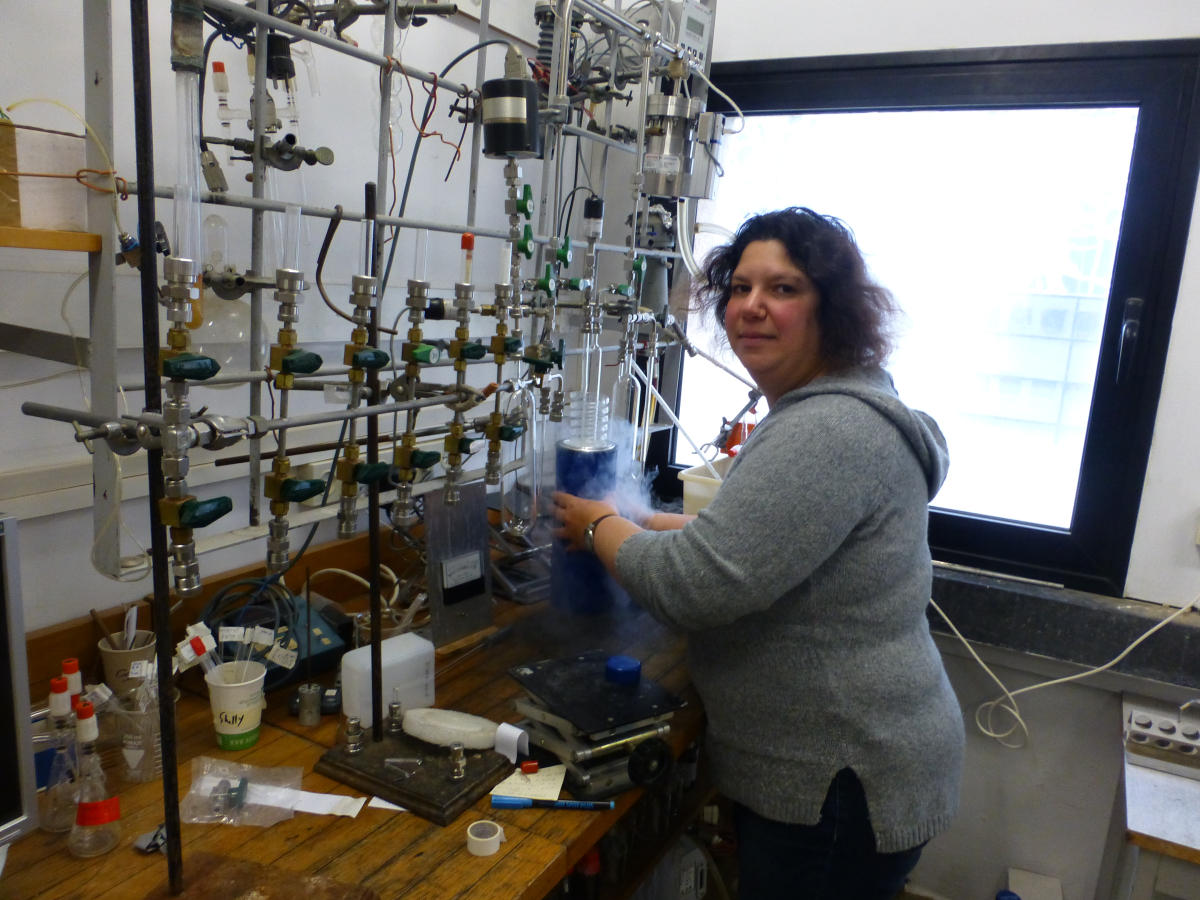הכירו את פרופ' חגית אפק, בוגרת המחלקה בקבוצתו של פרופ' דן יקיר
Date: February 7, 2023
חגית אפק התחילה את דרכה האקדמית אצל פרופ' דן יקיר במחלקה למדעי כדה"א וכוכבי הלכת במכון ויצמן. היום חגית היא פרופ' חבר במחלקה למדעי כדה"א באוניברסיטה העברית בירושלים.
Hagit Affek began her academic career with Prof. Dan Yakir in the EPS Department at the Weizmann Institute. Today, Hagit is an associate professor in the Department of Earth Sciences at the Hebrew University of Jerusalem.

חגית, היום פרופ' במחלקה למדעי כדה"א באוניבריסטה העברית, החלה את דרכה האקדמית כאשר עשתה תואר שני ולאחר מכן דוקטורט אצל פרופ' דן יקיר במחלקה למדעי כדה"א וכוכבי הלכת במכון ויצמן, אותו סיימה בשנת 2003.
המחקר של חגית אצל פרופ' דן יקיר עסק בפליטה של חומר שנקרא איזופרן מצמחיה. איזופרן היא מולקולה אורגנית נדיפה שמגיבה באטמוספירה וגורמת ליצירת אוזון טרופוספרי (האוזון "הרע") וכך גורמת להגברת זיהום האוויר. השאלה שעניינה אותם היתה – מדוע הצמח מבזבז אנרגיה ופחמן על יצירת איזופרן? מה המטרה? לכן בדקה חגית מה בפיזיולוגיה ובביוכימיה של הצמח משפיע על פליטת איזופרן. חגית השתמשה באיזוטופים של פחמן באיזופרן כדי להבין את המנגנון דרכו הוא נוצר בצמח ובעיקר לבדוק את השפעת העקה החמצונית על הצמח ומצאה שהיא מגבירה את פליטת האיזופרן. כך הבינה חגית מהמחקר שאיזופרן מספק הגנה כלשהי נגד עקה חמצונית ולכן הצמח משקיע בייצורו.
מה את עושה כעת בחיים ובאיזה תחום?
הלכתי רחוק מהמחקר בדוקטורט. עשיתי פוסט דוקטורט בקלטק בנושא איזוטופים מצומדים. השתמשנו בשיטה איזוטופית חדשה. הסמן האיזוטופי החדש שפיתחנו שימש אותנו לזיהוי מקורות פד״ח באוויר באזור לוס אנג׳לס.
אחרי הפוסט-דוק קיבלתי משרה כחברת סגל באוניברסיטת ייל בארה"ב, שם השתמשנו באותו סמן איזוטופי בקלציום קרבונט במטרה להבין מהם התנאים (במיוחד טמפרטורה) ליצירתו בים וביבשה ומתוך זה לעשות שחזור אקלים. בים בדקנו צדפות מתקופת האיאוקן (לפני 50 מליון שנים). ביבשה חקרנו משקעי מערות מלפני 150- 200 אלף שנים.
לפני 7 שנים קיבלתי הצעה מהמחלקה למדעי כדה"א באוניברסיטה העברית בירושלים ומאז אני פה כיוון שרציתי לחיות ולחקור בישראל. המחקר שלי נותר בתחום הקלציום קרבונט ושחזור האקלים והתרחב לפיתוח סמן איזוטופי חדש באיזוטופ O 17 (חמצן 17) בקלציום קרבונט, באמצעותו אנו מנסים להבין מקורות לחות ושינויים במעגל ההידרולוגי.
איך את מרגישה שהמחקר במחלקה עזר לך בהתפתחות האישית והמקצועית?
המחקר שלי היום הוא באופן טבעי המשכה של קריירה אקדמית, שכמובן לא ניתן להגשים ללא דוקטורט. היום אני מלמדת קורס בכימיה אטמוספרית שמתקשר למחקר שעשיתי בזמן הדוקטורט. האיזוטופים הם החוט המקשר בין המסטר, הדוקטורט לפוסט הדוקטורט ולמחקר שלי עד היום. בסופו של דבר, ההכשרה שקיבלתי במכון ויצמן הובילה אותי לגיאוכימיה איזוטופית.
מהן השאיפות שלך לעתיד?
להמשיך לעשות מחקר מעניין ולנסות לקחת את פיתוח השיטות שלי ליישומים של שחזור אקלים.
מסר ממך לסטודנטים שבאים למחלקה.
תעשו את מה שמעניין אתכם ושאתם אוהבים. מחקר מדעי הוא עבודה קשה וצריך לאהוב אותו כדי לעשות אותו היטב.

Hagit, a professor in the Department of Earth Sciences at the Hebrew University, began her academic career when she earned a master's degree and then a PhD with Prof. Dan Yakir from the EPS at the Weizmann Institute, where she graduated in 2003.
Hagit's research with Prof. Dan Yakir focused on the emission of a molecule called isoprene from plants. Isoprene is a volatile organic compound that reacts in the atmosphere and causes the formation of tropospheric ozone (the "bad" ozone), thereby increasing air pollution. They wanted to know why the plant wastes energy and carbon to create isoprene. What was the point? Therefore, Hagit investigated which part of the plant's physiology and biochemistry affected the emission of isoprene. Hagit used carbon isotopes in isoprene to elucidate the mechanism through which it is formed in the plant and, mostly, to test the effect of oxidative stress on the plant and found that it increased the emission of isoprene. Consequently, Hagit discovered that isoprene provided certain protection against oxidative stress, therefore investing in its production.
What is your current field of interest?
I wandered far from my PhD topic. I did a post-doctorate at Caltech on conjugated isotopes. We used a new isotopic method. The novel isotopic marker we developed was used to identify CO2 sources in the atmosphere of the Los Angeles area.
After my post-doctorate, I got a position as a faculty member at Yale University, where we used the same isotopic marker in calcium carbonate to understand what the conditions (especially temperature) were for its formation in the sea and on land and used the results for climate reconstruction. In the sea, we examined oysters from the Eocene period (50 million years ago). On land, we explored cave sediments from 150-200 thousand years ago.
Seven years ago, I received an offer from the Department of Earth Sciences at the Hebrew University of Jerusalem, and since then, I have been here because I wanted to live and conduct research in Israel. My research remained in the field of calcium carbonate and climate reconstruction and expanded to the development of a new isotopic marker in the O17 isotope (oxygen 17) in calcium carbonate, through which we attempt to understand humidity sources and changes in the hydrological cycle.
How has the research in the department helped you in your personal and professional development?
My research today is naturally a continuation of an academic career, which, of course, cannot be accomplished without a PhD. Today, I teach a course in atmospheric chemistry linked to the research I conducted during my PhD. The isotopes are the thread connecting the master's, the PhD, the post-doctorate, and my research to this day. Ultimately, the training I received at the Weizmann Institute led me to isotopic geochemistry.
What are your future aspirations?
I wish to continue doing interesting research and introducing the development of my methods into climate reconstruction applications.
What would be your message to students coming to our department?
Do what interests you and what you love. Scientific research is hard work, and you have to love it to do it well
